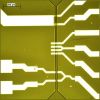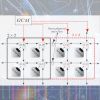Measurement and Electronic Architectures group

Microelectrodes implanted in a microfluidic channel. Unit characterization of biological cells by bio-impedance measurement in flow cytometry

Artificial neural network carried out on a parallel and distributed architecture based on a NoC chip network intended for implantation on a reconfigurable technology of the FPGA type

Laboratory prototype of an embedded electronic system for robust detection of electric arc faults.
The system is designed around a System-on-a-Chip (SoC) and a current sensor conditioning circuit
Last publications
- Series Arc Fault Detection Method Based on Time Domain Imaging and Long Short-Term Memory Network for Residential Applications
Ruobo Chu, Schweitzer Patrick, Kai Yang
Algorithms, 2025, 18 (8), pp.497. ⟨10.3390/a18080497⟩ - Détection des défauts d'arc par radiation électromagnétique utilisant la technologie des antennes
Rafael Charca-Benavente, Jinmi Lezama, Mark Clemente Arenas, Patrick Schweitzer
Journal International de Technologie, de l'Innovation, de la Physique, de l'Energie et de l'Environnement , 2025, 9 (1), ⟨10.52497/jitipee.v9i1.378⟩ - Real-Time Series Arc Fault Detection and Appliances Classification in AC Networks Based on Competing Convolutional Kernels
Francesco Ferracuti, Riccardo Felicetti, Luca Cavanini, Patrick Schweitzer, Andrea Monteriù
IEEE Open Journal of the Industrial Electronics Society, 2025, 6, pp.1050-1065. ⟨10.1109/OJIES.2025.3582482⟩
Presentation
The MAE group specialises in the design of intelligent and autonomous sensors and electronic measuring systems. The fields of application of these are multiple and respond to societal issues, health, energy efficiency, industrial renewal.
The expertise of the group members enables them to address design issues of embedded electronic systems at different levels: From sensors (especially biosensors) to the system integrating complex and fast signal processing.
The approach takes aspects of machine learning, fault tolerance and problems of energy consumption and recovery.
The research carried out by the group focuses on intelligent and autonomous sensors and electronic systems with two complementary axes:
- Sensors, instrumentation and measurement
- Electronic circuit architectures and systems
Research topics
Sensors, instrumentation and measurement
Bio-impedance spectroscopy is an extremely important diagnostic tool for the study of electrophysiological and biophysical changes due to viral infections, cancer detection and drug quality control. The use of microelectrodes has several fields of application related to medical diagnosis such as:
- single cell characterization
- detection of changes induced during cell culture
- the study of the environment/biological tissue interaction at the cellular level
Modelling of the whole system (biosensor loaded by a biological medium) allows optimisation of interfaces, which involves very advanced theoretical developments in electromagnetism, electronics and characterization of materials. This approach also helps optimize the dimensioning of microelectrodes. The development of biosensors and their functionalization constitutes an important criterion for the optimal transduction of the biological signal. The work carried out by the group concerns:
- optimization of the electrode-living environment interfaces
- improvement of sensitivity
- optimized calibration
- electronic conditioning and multiplexing for a biosensor array
The challenges involved are to develop of these methods at application scales beyond the prototype to aim for added value compared to existing techniques.
As an example, the detection of the E.coli bacterium requires at least 48 hours using conventional techniques. Impedance spectroscopy would make it possible to lower this to a few minutes or even seconds. Similarly, cell characterization by a bio-impedance-metric signature can concern several thousand cells or hundreds of cell aggregates. The objective is to develop a multi-sensor matrix allowing such an approach, with the possibility of combining different types of characterization (healthy cells versus malignant ones) or biological media (erythrocytes, intestinal cell).
Projects:
- Collaboration contract with the Réseau de Transport d’Electricité (RTE)
- Smartstim collaboration project (80 Prime of the CNRS)
- Project LUE Thesis « support for interdisciplinary dynamics » (2022-2025) "Ex-vivo Model of Inflammatory Bowel"
Thesis:
- Mengxi Zhou, CEM of low frequency (50/60 Hz) cardiac implants at a normative context Contract RTE, 2020-2023
- Rémi Bettenfeld : Cellular scale impedance spectroscopy study of the electromagnetic fields effects between 1 kHz and 100 MHz, Doctoral contract, 2020-2023
Articles:
- Phantom Model Testing of Active Implantable Cardiac Devices at 50/60 Hz Electric Field, C. Gerçek, D. Kourtiche, M. Nadi,I. Magne, P. Schmitt, P. Roth,M. Souques‘BioElectroMagnetics, January 2020
- Influence of Electrode Connection Tracks on Biological Cell Measurements by Impedance Spectroscopy, Alves de Araujo, A. L., Claudel, J., Kourtiche, D., Nadi, M. Sensors, 2019, vol. 19, no 13, p. 2839.
- Lab-On-A-Chip Device for Yeast Cell Characterization in Low-Conductivity Media Combining Cytometry and Bio-Impedance, Claudel, J., Alves De Araujo, A. L., Nadi, M., Kourtiche, D.. Sensors, 2019, vol. 19, no 15, p. 3366
- Optimization of Interdigitated Sensor Characteristics. In Interdigital Sensors J., Claudel, A. L., Alves de Araujo, D., Kourtiche, M., Nadi, A. Bourjilat, 2021. (pp. 91-122). Springer, Cham.
- Interference thresholds for active implantable cardiovascular devices in occupational low-frequency electric and magnetic fields: a numerical and in vitro study. M., Zhou, D., Kourtiche, J., Claudel, F., Deschamps, I., Magne, P., Roth, ... & M., Nadi, 2022. Medical Engineering & Physic
Architectures of circuits and electronic systems
Reconfigurable architectures are one of the group's areas of expertise. The work in progress is more specifically devoted to neuromorphic architectures on reconfigurable targets for signal and image processing. This concerns the implementation of neural networks ( self-organizing maps (SOM), convolutive network and transformer) on embedded electronic architectures.
The main objective is to make current neuronal and/or neuromorphic hardware architectures more flexible and more easily scalable while remaining competitive in terms of performance. These architectures are based on a hybrid approach allowing to decouple the computational layer, essentially composed of neurons, from the communication layer, which ensures the exchange of data between the neurons themselves and with the external world (with a Network on chip (NoC) for example). Other neural network structures are also being explored and prototyped on SoC and MPSoC platforms.
The work on circuit architectures is used to design intelligent, autonomous and communicating electronic measurement systems with very high added value. The team is particularly interested in electronic systems for detecting complex phenomena or anomalies in one- or two-dimensional signals.
The objectives are the detection of electrical arcs faults (aeronautic, photovoltaic, domestic) or the characterization of physiological phenomena (state of alertness, epilepsy, ...) in ECG, EEG signals .... This concens also the tracking of objects and the tracking of apparent movements in video sequences. The team implements embedded technologies as close as possible to the sensors and using machine learning methods with hardware acceleration.
The research work on energy autonomy and operational safety concerns the study, design and development of optimized and reliable electrical energy micro-sources, with or without storage. Our efforts are focused on the optimization of maximum power point tracking algorithms adapted to hybrid sources combining photovoltaic and thermoelectric generators. Moreover, our future work on intermittent computing will also allow us to take into account energy availability when designing new computing architectures (neural and/or neuromorphic or others) in order to make them more sustainable and respectful of the working environment.
Projects:
- Ecos-Nord with Mexico concerning the design of converters for photovoltaic panels incorporating protection against series arcing faults. (Find out more)
- ANR PRC « Hybrid photovoltaic-thermoelectric systems for solar energy harvesting » (HYDRES) 2022 – 2025.
- Erasmus+: Higher Education - International Capacity Building (Unit A4)
Theses:
- Rabiaa Lachter, Embedded system for the detection of hypovigilance while driving, Cotutelle with the LTIM Monastir, Tunisia, 2019 – 2023
- Shireen Ansarnia, Development and implementation of artificial intelligence and vision algorithms for the dynamic management of urban lighting, Cifre thesis, 2020-2023
- Alexis Chabert: Neural network architecture for arc fault detection: application to embedded aeronautical distribution systems. Collaboration with IRT Saint Exupéry –Toulouse, 2020-2023
- Deramgozin Mohammad Mahdi, Tools and Methods for Approximate Computation in Machine Learning: Application to 3D Imaging and Home Assistance, AvaKaghaz grant, 2019-2022.
Articles:
- Application of Reservoir Computing for the Modeling of Nano-Contact Vortex Oscillator, Ali Rida Ismail, Slavisa Jovanovic, Sébastien Petit-Watelot and Hassan Rabah, Electronics 2019, 8 (11), 1315.
- An FPGA-Based Residual Recurrent Neural Network for Real-Time Video Super-Resolution, K. Sun, M. Koch, Z. Wang, S. Jovanovic, H. Rabah and S. Simon, IEEE Transactions on Circuits and Systems for Video Technology, vol. 32, no. 4, pp. 1739-1750, April 2022, doi: 10.1109/TCSVT.2021.3080241.
- Serial-arc detection by use of Spectral Dispersion Index (SDI) analysis in a low-voltage network (270V HVDC), Jean Baptiste Humbert, Patrick Schweitzer, Serge Weber, Electric Power Systems Research,Volume 196, 2021, 107084.
- Open-switch Fault Tolerant Operation of a Two-Stage Buck/Buck-Boost Converter with redundant synchronous switch for PV systems, Saïma Siouane, Slavisa Jovanovic, Philippe Poure, IEEE Transactions on Industrial Electronics, Vol. 66, Issue 5, May 2019, pp. 3938-3947.
Know-how
Processing
- Low frequency electromagnetic measurements on living organisms
- Design, sizing and synthesis of biosensors for measurements by cellular impedance spectroscopy
- Design of embedded circuits for electric arc fault detection and localization
- Design of architectures on reconfigurable circuits for signal and image processing
- Methods for tracking the maximum power point of hybrid renewable energy sources.
Characterization
- Electromagnetic characterization of biological cells
- Characterization of tensions induced in active medical implants subjected to low frequency fields
- Impedance spectroscopy
Technological transfer
- CENELEC normalization
- Transfer to the Leach International company of an electric arc fault detection device for aeronautics in the form of a joint patent
- Transfer to the Hager Group of the technology for the detection of electric arc defects for domestic electric networks
Members
Professors, assistant professors
- Yves BERVILLER
- Julien CLAUDEL
- Djamaleddine DJELDJLI
- Slavisa JOVANOVIC
- Djilali KOURTICHE
- Philippe POURE
- Hassan RABAH
- Patrick SCHWEITZER
- Etienne TISSERAND
- Serge WEBER
Technical and support staff
- Patrice ROTH
- Pierre SCHMITT
PhD students
- Zewalina AMADOU
- Pacôme COLIN
- Florent DERUE
- Niloufar DIZANGIAN
- Mashiul HUQ
- Agathe LEMEE
- Merlin LIMON
- Abdelhak MAOUKOUF
Emeritus
- Mustapha NADI
Publications
Contact
Head of the group
Patrick SCHWEITZER
patrick.schweitzer@univ-lorraine.fr
+33 (0) 3 72 74 27 15
Nancy-Artem
Institut Jean Lamour
Campus Artem
2 allée André Guinier - BP 50840
54011 NANCY Cedex
